PRESENTATION OF THE 7 FORM PUPIL BLINKOVA ZLATATHE


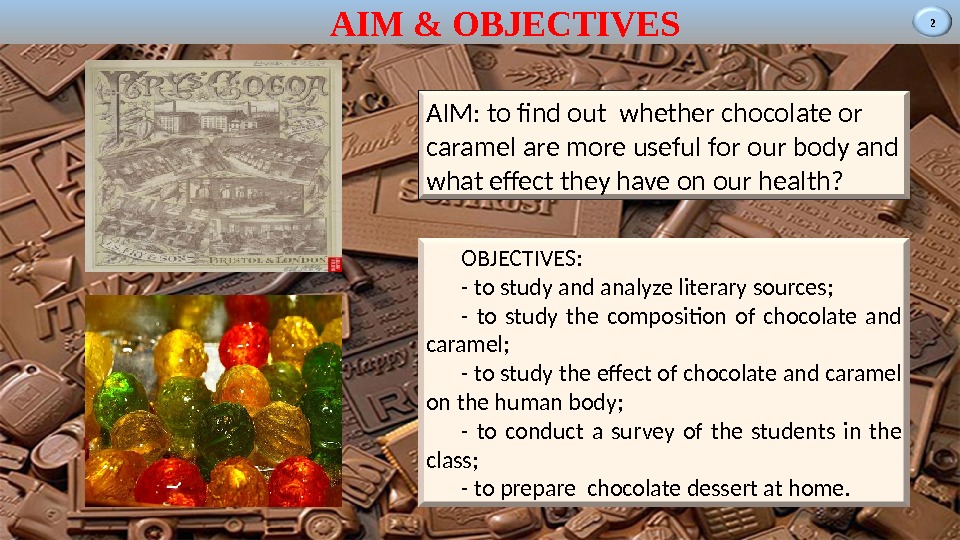

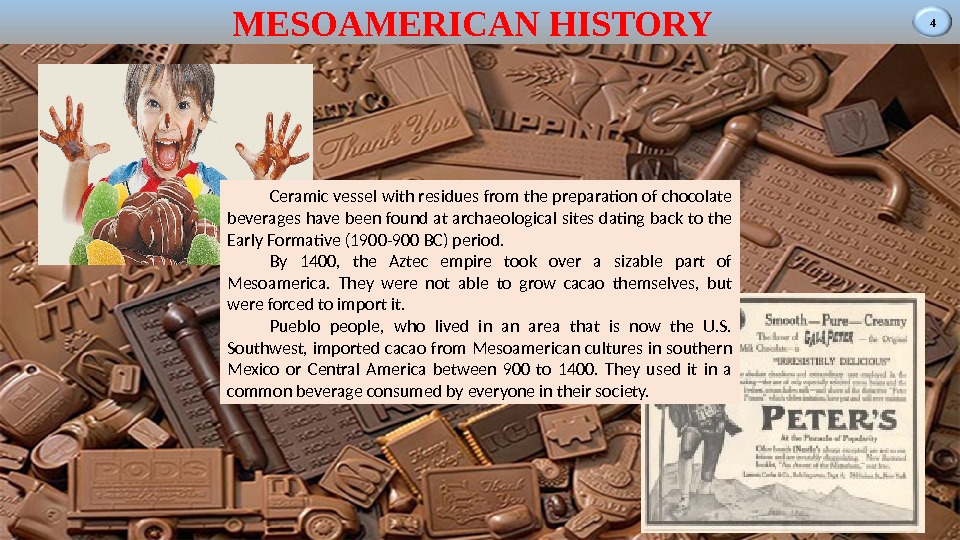
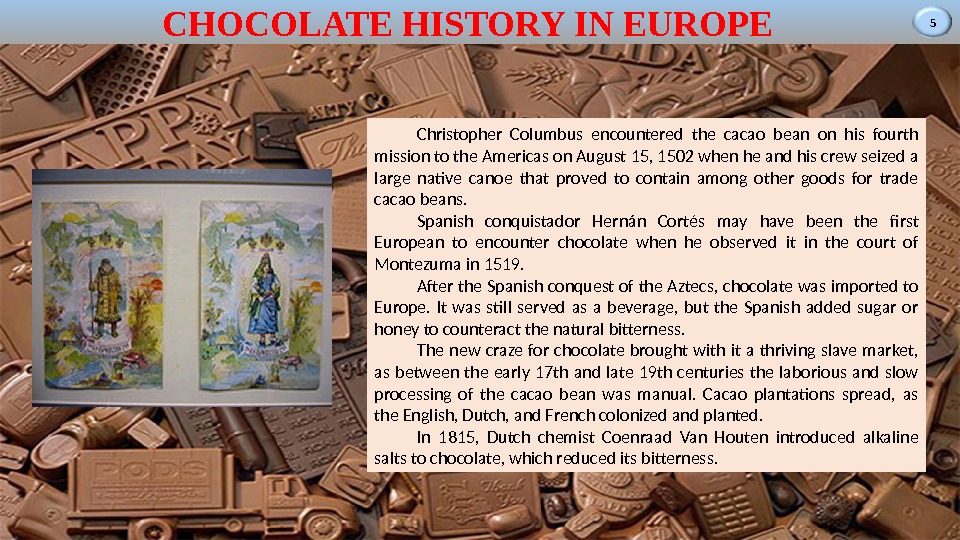
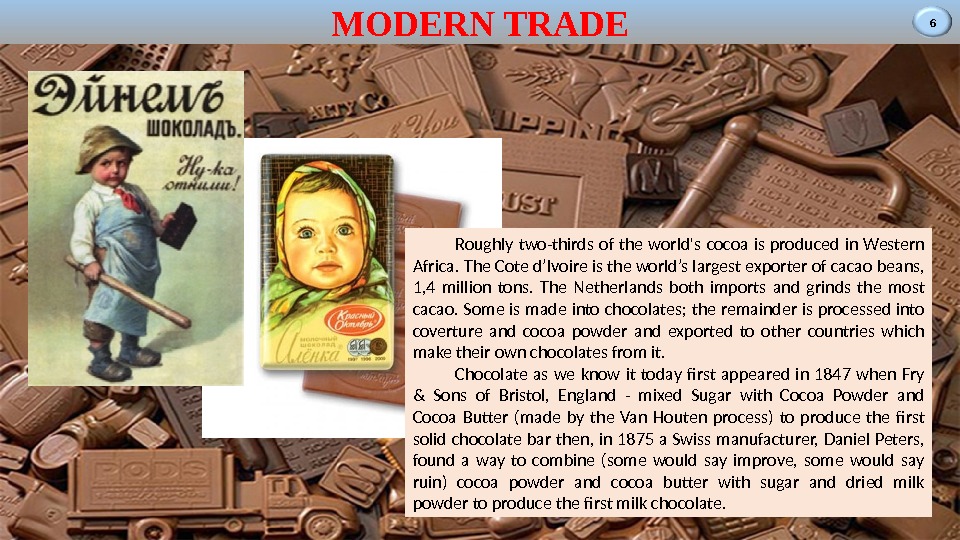
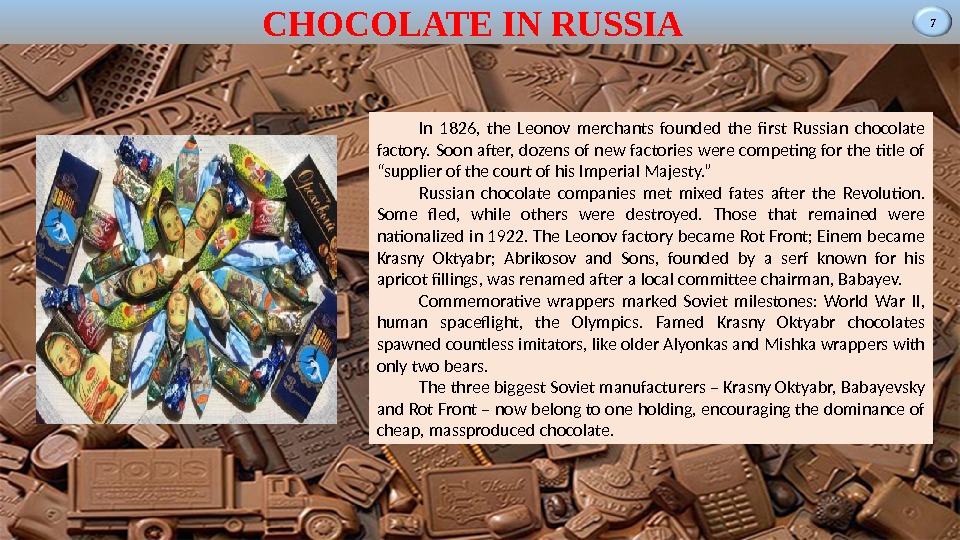
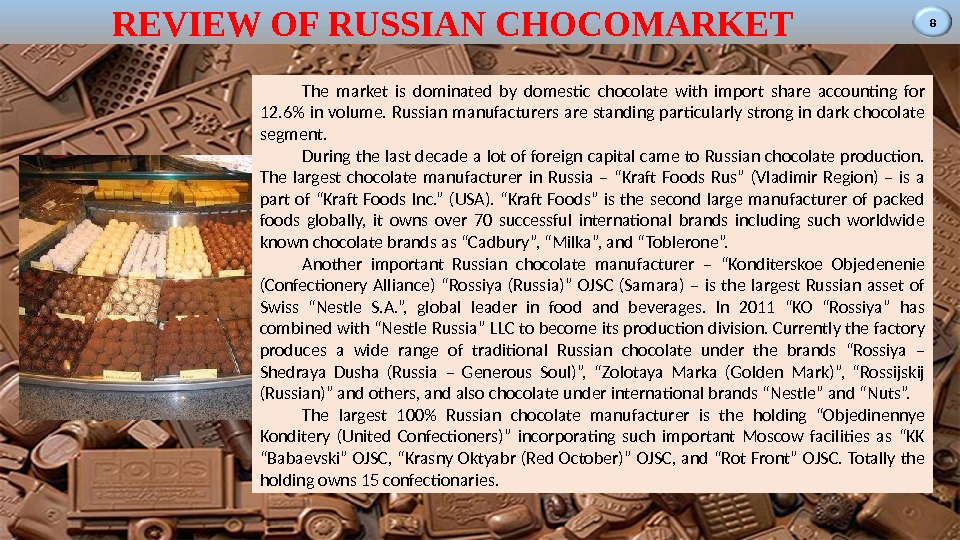
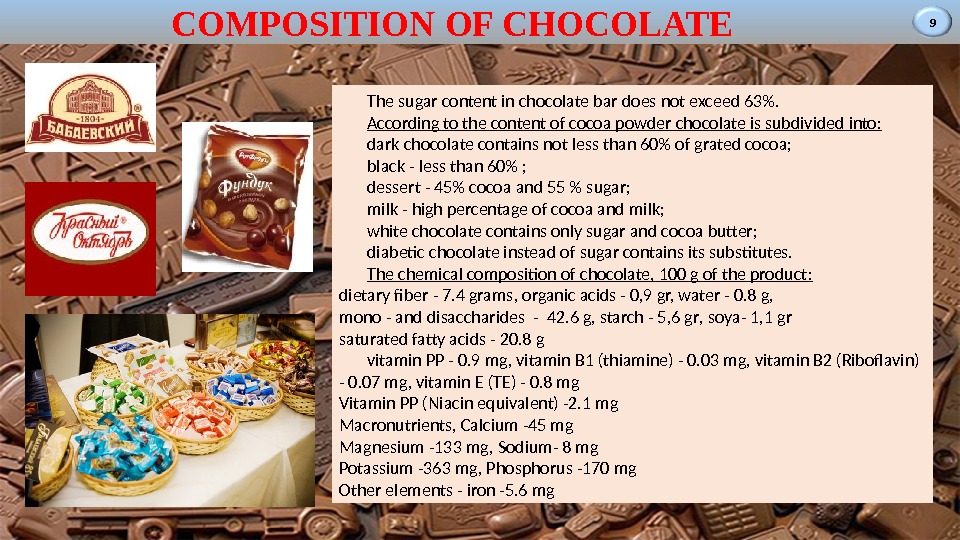
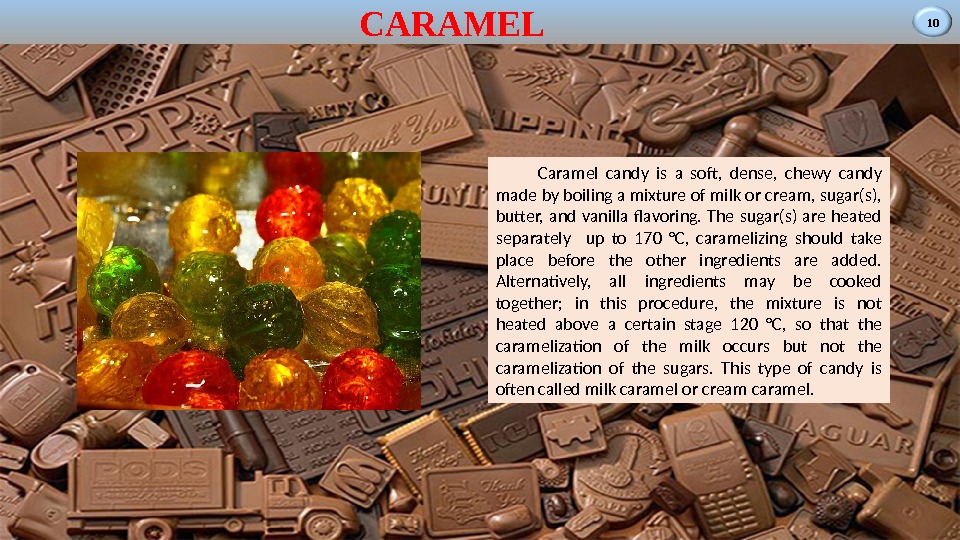
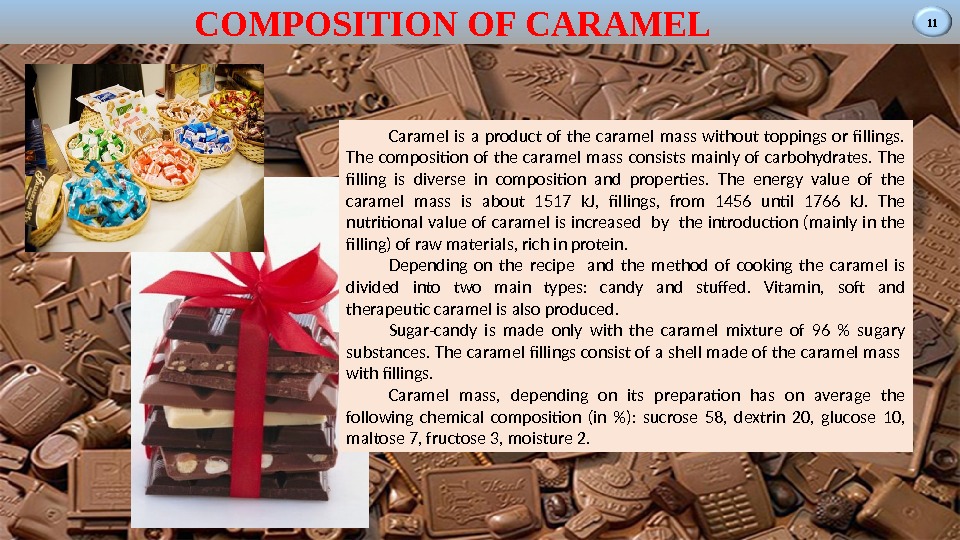
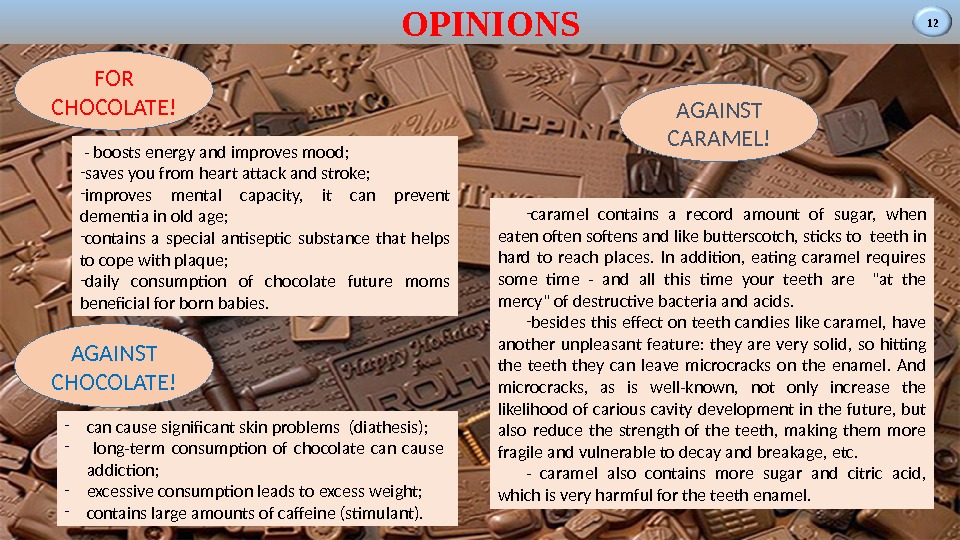
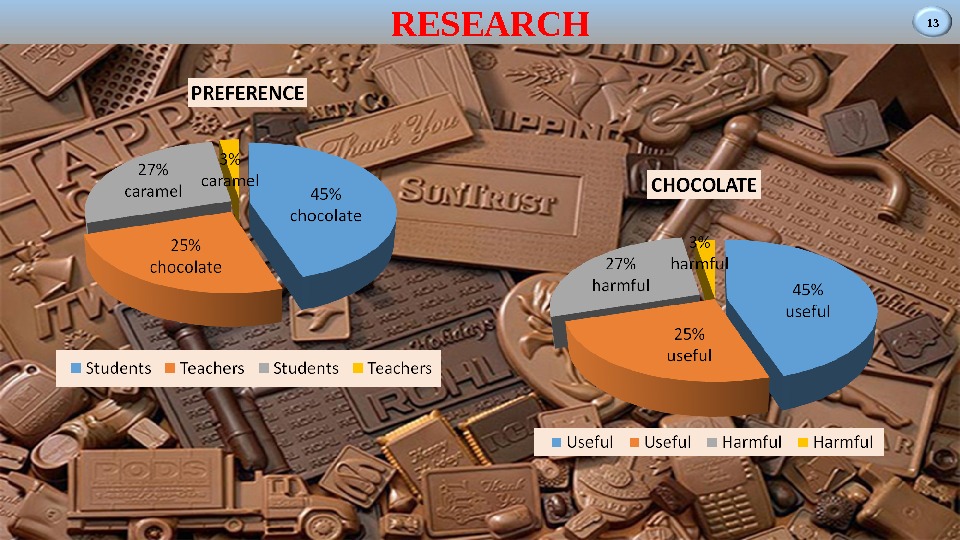

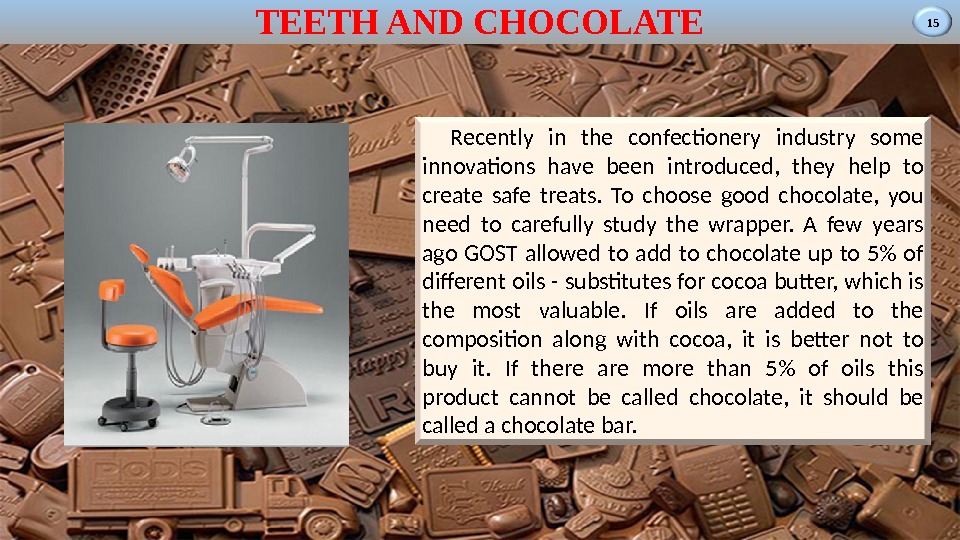
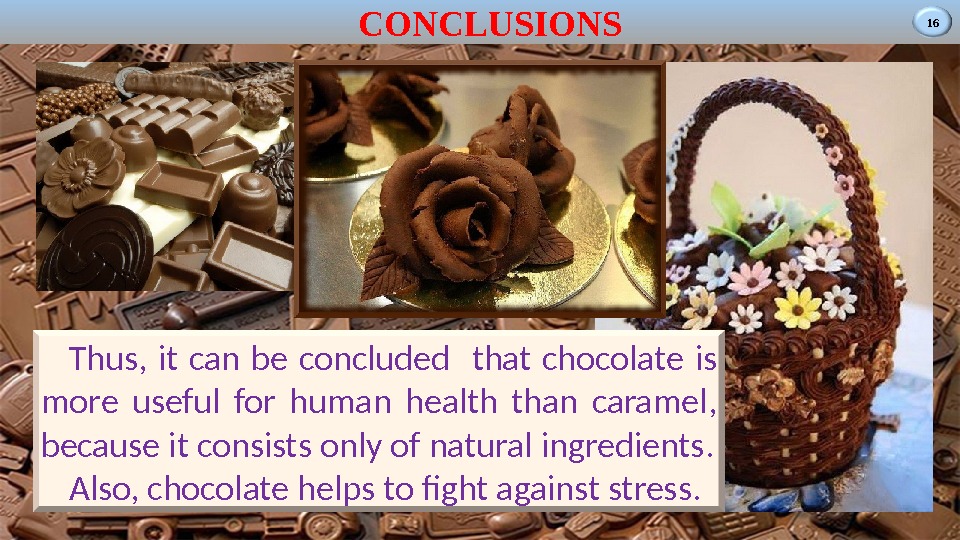

chocolate_english_blinkova_zlata.ppt
- Размер: 16.4 Mегабайта
- Количество слайдов: 17
Описание презентации PRESENTATION OF THE 7 FORM PUPIL BLINKOVA ZLATATHE по слайдам
 PRESENTATION OF THE 7 FORM PUPIL BLINKOVA ZLATATHE DRINK OF GODS
PRESENTATION OF THE 7 FORM PUPIL BLINKOVA ZLATATHE DRINK OF GODS
 2 AIM & OBJECTIVES AIM: to find out whether chocolate or caramel are more useful for our body and what effect they have on our health? OBJECTIVES: — to study and analyze literary sources; — to study the composition of chocolate and caramel; — to study the effect of chocolate and caramel on the human body; — to conduct a survey of the students in the class; — to prepare chocolate dessert at home.
2 AIM & OBJECTIVES AIM: to find out whether chocolate or caramel are more useful for our body and what effect they have on our health? OBJECTIVES: — to study and analyze literary sources; — to study the composition of chocolate and caramel; — to study the effect of chocolate and caramel on the human body; — to conduct a survey of the students in the class; — to prepare chocolate dessert at home.
 3 HISTORY OF CHOCOLATE The history of chocolate begins in Mesoamerica. Chocolate, the fermented, roasted, and ground beans of the Theobroma cacao, can be traced to the Mokaya and other pre-Olmec people, with evidence of chocolate beverages dating back to 1900 BC. Originally prepared only as a drink, chocolate was served as a bitter, frothy liquid, mixed with spices, wine or corn puree. It was believed to have aphrodisiac powers and to give the drinker strength. After its arrival in Spain in the sixteenth century, sugar was added to it and it became popular through Europe. In the 20 th century, chocolate was considered a staple, essential in the rations of United States soldiers at war.
3 HISTORY OF CHOCOLATE The history of chocolate begins in Mesoamerica. Chocolate, the fermented, roasted, and ground beans of the Theobroma cacao, can be traced to the Mokaya and other pre-Olmec people, with evidence of chocolate beverages dating back to 1900 BC. Originally prepared only as a drink, chocolate was served as a bitter, frothy liquid, mixed with spices, wine or corn puree. It was believed to have aphrodisiac powers and to give the drinker strength. After its arrival in Spain in the sixteenth century, sugar was added to it and it became popular through Europe. In the 20 th century, chocolate was considered a staple, essential in the rations of United States soldiers at war.
 4 MESOAMERICAN HISTORY Ceramic vessel with residues from the preparation of chocolate beverages have been found at archaeological sites dating back to the Early Formative (1900 -900 BC) period. By 1400, the Aztec empire took over a sizable part of Mesoamerica. They were not able to grow cacao themselves, but were forced to import it. Pueblo people, who lived in an area that is now the U. S. Southwest, imported cacao from Mesoamerican cultures in southern Mexico or Central America between 900 to 1400. They used it in a common beverage consumed by everyone in their society.
4 MESOAMERICAN HISTORY Ceramic vessel with residues from the preparation of chocolate beverages have been found at archaeological sites dating back to the Early Formative (1900 -900 BC) period. By 1400, the Aztec empire took over a sizable part of Mesoamerica. They were not able to grow cacao themselves, but were forced to import it. Pueblo people, who lived in an area that is now the U. S. Southwest, imported cacao from Mesoamerican cultures in southern Mexico or Central America between 900 to 1400. They used it in a common beverage consumed by everyone in their society.
 5 CHOCOLATE HISTORY IN EUROPE Christopher Columbus encountered the cacao bean on his fourth mission to the Americas on August 15, 1502 when he and his crew seized a large native canoe that proved to contain among other goods for trade cacao beans. Spanish conquistador Hernán Cortés may have been the first European to encounter chocolate when he observed it in the court of Montezuma in 1519. After the Spanish conquest of the Aztecs, chocolate was imported to Europe. It was still served as a beverage, but the Spanish added sugar or honey to counteract the natural bitterness. The new craze for chocolate brought with it a thriving slave market, as between the early 17 th and late 19 th centuries the laborious and slow processing of the cacao bean was manual. Cacao plantations spread, as the English, Dutch, and French colonized and planted. In 1815, Dutch chemist Coenraad Van Houten introduced alkaline salts to chocolate, which reduced its bitterness.
5 CHOCOLATE HISTORY IN EUROPE Christopher Columbus encountered the cacao bean on his fourth mission to the Americas on August 15, 1502 when he and his crew seized a large native canoe that proved to contain among other goods for trade cacao beans. Spanish conquistador Hernán Cortés may have been the first European to encounter chocolate when he observed it in the court of Montezuma in 1519. After the Spanish conquest of the Aztecs, chocolate was imported to Europe. It was still served as a beverage, but the Spanish added sugar or honey to counteract the natural bitterness. The new craze for chocolate brought with it a thriving slave market, as between the early 17 th and late 19 th centuries the laborious and slow processing of the cacao bean was manual. Cacao plantations spread, as the English, Dutch, and French colonized and planted. In 1815, Dutch chemist Coenraad Van Houten introduced alkaline salts to chocolate, which reduced its bitterness.
 6 MODERN TRADE Roughly two-thirds of the world’s cocoa is produced in Western Africa. The Cote d’Ivoire is the world’s largest exporter of cacao beans, 1 , 4 million tons. The Netherlands both imports and grinds the most cacao. Some is made into chocolates; the remainder is processed into coverture and cocoa powder and exported to other countries which make their own chocolates from it. Chocolate as we know it today first appeared in 1847 when Fry & Sons of Bristol, England — mixed Sugar with Cocoa Powder and Cocoa Butter (made by the Van Houten process) to produce the first solid chocolate bar then, in 1875 a Swiss manufacturer, Daniel Peters, found a way to combine (some would say improve, some would say ruin) cocoa powder and cocoa butter with sugar and dried milk powder to produce the first milk chocolate.
6 MODERN TRADE Roughly two-thirds of the world’s cocoa is produced in Western Africa. The Cote d’Ivoire is the world’s largest exporter of cacao beans, 1 , 4 million tons. The Netherlands both imports and grinds the most cacao. Some is made into chocolates; the remainder is processed into coverture and cocoa powder and exported to other countries which make their own chocolates from it. Chocolate as we know it today first appeared in 1847 when Fry & Sons of Bristol, England — mixed Sugar with Cocoa Powder and Cocoa Butter (made by the Van Houten process) to produce the first solid chocolate bar then, in 1875 a Swiss manufacturer, Daniel Peters, found a way to combine (some would say improve, some would say ruin) cocoa powder and cocoa butter with sugar and dried milk powder to produce the first milk chocolate.
 7 CHOCOLATE IN RUSSIA In 1826, the Leonov merchants founded the first Russian chocolate factory. Soon after, dozens of new factories were competing for the title of “supplier of the court of his Imperial Majesty. ” Russian chocolate companies met mixed fates after the Revolution. Some fled, while others were destroyed. Those that remained were nationalized in 1922. The Leonov factory became Rot Front; Einem became Krasny Oktyabr; Abrikosov and Sons, founded by a serf known for his apricot fillings, was renamed after a local committee chairman, Babayev. Commemorative wrappers marked Soviet milestones: World War II, human spaceflight, the Olympics. Famed Krasny Oktyabr chocolates spawned countless imitators, like older Alyonkas and Mishka wrappers with only two bears. The three biggest Soviet manufacturers – Krasny Oktyabr, Babayevsky and Rot Front – now belong to one holding, encouraging the dominance of cheap, massproduced chocolate.
7 CHOCOLATE IN RUSSIA In 1826, the Leonov merchants founded the first Russian chocolate factory. Soon after, dozens of new factories were competing for the title of “supplier of the court of his Imperial Majesty. ” Russian chocolate companies met mixed fates after the Revolution. Some fled, while others were destroyed. Those that remained were nationalized in 1922. The Leonov factory became Rot Front; Einem became Krasny Oktyabr; Abrikosov and Sons, founded by a serf known for his apricot fillings, was renamed after a local committee chairman, Babayev. Commemorative wrappers marked Soviet milestones: World War II, human spaceflight, the Olympics. Famed Krasny Oktyabr chocolates spawned countless imitators, like older Alyonkas and Mishka wrappers with only two bears. The three biggest Soviet manufacturers – Krasny Oktyabr, Babayevsky and Rot Front – now belong to one holding, encouraging the dominance of cheap, massproduced chocolate.
 8 REVIEW OF RUSSIAN CHOCOMARKET The market is dominated by domestic chocolate with import share accounting for 12. 6% in volume. Russian manufacturers are standing particularly strong in dark chocolate segment. During the last decade a lot of foreign capital came to Russian chocolate production. The largest chocolate manufacturer in Russia – “Kraft Foods Rus” (Vladimir Region) – is a part of “Kraft Foods Inc. ” (USA). “Kraft Foods” is the second large manufacturer of packed foods globally, it owns over 70 successful international brands including such worldwide known chocolate brands as “Cadbury”, “Milka”, and “Toblerone”. Another important Russian chocolate manufacturer – “Konditerskoe Objedenenie (Confectionery Alliance) “Rossiya (Russia)” OJSC (Samara) – is the largest Russian asset of Swiss “Nestle S. A. ”, global leader in food and beverages. In 2011 “KO “Rossiya” has combined with “Nestle Russia” LLC to become its production division. Currently the factory produces a wide range of traditional Russian chocolate under the brands “Rossiya – Shedraya Dusha (Russia – Generous Soul)”, “Zolotaya Marka (Golden Mark)”, “Rossijskij (Russian)” and others, and also chocolate under international brands “Nestle” and “Nuts”. The largest 100% Russian chocolate manufacturer is the holding “Objedinennye Konditery (United Confectioners)” incorporating such important Moscow facilities as “KK “Babaevski” OJSC, “Krasny Oktyabr (Red October)” OJSC, and “Rot Front” OJSC. Totally the holding owns 15 confectionaries.
8 REVIEW OF RUSSIAN CHOCOMARKET The market is dominated by domestic chocolate with import share accounting for 12. 6% in volume. Russian manufacturers are standing particularly strong in dark chocolate segment. During the last decade a lot of foreign capital came to Russian chocolate production. The largest chocolate manufacturer in Russia – “Kraft Foods Rus” (Vladimir Region) – is a part of “Kraft Foods Inc. ” (USA). “Kraft Foods” is the second large manufacturer of packed foods globally, it owns over 70 successful international brands including such worldwide known chocolate brands as “Cadbury”, “Milka”, and “Toblerone”. Another important Russian chocolate manufacturer – “Konditerskoe Objedenenie (Confectionery Alliance) “Rossiya (Russia)” OJSC (Samara) – is the largest Russian asset of Swiss “Nestle S. A. ”, global leader in food and beverages. In 2011 “KO “Rossiya” has combined with “Nestle Russia” LLC to become its production division. Currently the factory produces a wide range of traditional Russian chocolate under the brands “Rossiya – Shedraya Dusha (Russia – Generous Soul)”, “Zolotaya Marka (Golden Mark)”, “Rossijskij (Russian)” and others, and also chocolate under international brands “Nestle” and “Nuts”. The largest 100% Russian chocolate manufacturer is the holding “Objedinennye Konditery (United Confectioners)” incorporating such important Moscow facilities as “KK “Babaevski” OJSC, “Krasny Oktyabr (Red October)” OJSC, and “Rot Front” OJSC. Totally the holding owns 15 confectionaries.
 9 COMPOSITION OF CHOCOLATE The sugar content in chocolate bar does not exceed 63%. According to the content of cocoa powder chocolate is subdivided into: dark chocolate contains not less than 60% of grated cocoa; black — less than 60% ; dessert — 45% cocoa and 55 % sugar; milk — high percentage of cocoa and milk; white chocolate contains only sugar and cocoa butter; diabetic chocolate instead of sugar contains its substitutes. The chemical composition of chocolate, 100 g of the product : dietary fiber — 7. 4 grams , organic acids — 0, 9 gr, water — 0. 8 g , mono — and disaccharides — 42. 6 g, starch — 5, 6 gr , soya- 1, 1 gr saturated fatty acids — 20. 8 g vitamin PP — 0. 9 mg , vitamin B 1 (thiamine) — 0. 03 mg, vitamin B 2 (Riboflavin) — 0. 07 mg , vitamin E (TE) — 0. 8 mg Vitamin PP (Niacin equivalent) -2. 1 mg Macronutrients , Calcium -45 mg Magnesium -133 mg , Sodium- 8 mg Potassium -363 mg , Phosphorus -170 mg Other elements — iron -5. 6 mg
9 COMPOSITION OF CHOCOLATE The sugar content in chocolate bar does not exceed 63%. According to the content of cocoa powder chocolate is subdivided into: dark chocolate contains not less than 60% of grated cocoa; black — less than 60% ; dessert — 45% cocoa and 55 % sugar; milk — high percentage of cocoa and milk; white chocolate contains only sugar and cocoa butter; diabetic chocolate instead of sugar contains its substitutes. The chemical composition of chocolate, 100 g of the product : dietary fiber — 7. 4 grams , organic acids — 0, 9 gr, water — 0. 8 g , mono — and disaccharides — 42. 6 g, starch — 5, 6 gr , soya- 1, 1 gr saturated fatty acids — 20. 8 g vitamin PP — 0. 9 mg , vitamin B 1 (thiamine) — 0. 03 mg, vitamin B 2 (Riboflavin) — 0. 07 mg , vitamin E (TE) — 0. 8 mg Vitamin PP (Niacin equivalent) -2. 1 mg Macronutrients , Calcium -45 mg Magnesium -133 mg , Sodium- 8 mg Potassium -363 mg , Phosphorus -170 mg Other elements — iron -5. 6 mg
 10 CARAMEL Caramel candy is a soft, dense, chewy candy made by boiling a mixture of milk or cream, sugar(s), butter, and vanilla flavoring. The sugar(s) are heated separately up to 170 °C, caramelizing should take place before the other ingredients are added. Alternatively, all ingredients may be cooked together; in this procedure, the mixture is not heated above a certain stage 120 °C, so that the caramelization of the milk occurs but not the caramelization of the sugars. This type of candy is often called milk caramel or cream caramel.
10 CARAMEL Caramel candy is a soft, dense, chewy candy made by boiling a mixture of milk or cream, sugar(s), butter, and vanilla flavoring. The sugar(s) are heated separately up to 170 °C, caramelizing should take place before the other ingredients are added. Alternatively, all ingredients may be cooked together; in this procedure, the mixture is not heated above a certain stage 120 °C, so that the caramelization of the milk occurs but not the caramelization of the sugars. This type of candy is often called milk caramel or cream caramel.
 11 COMPOSITION OF CARAMEL Caramel is a product of the caramel mass without toppings or fillings. The composition of the caramel mass consists mainly of carbohydrates. The filling is diverse in composition and properties. The energy value of the caramel mass is about 1517 k. J, fillings, from 1456 until 1766 k. J. The nutritional value of caramel is increased by the introduction (mainly in the filling) of raw materials, rich in protein. Depending on the recipe and the method of cooking the caramel is divided into two main types: candy and stuffed. Vitamin, soft and therapeutic caramel is also produced. Sugar-candy is made only with the caramel mixture of 96 % sugary substances. The caramel fillings consist of a shell made of the caramel mass with fillings. Caramel mass, depending on its preparation has on average the following chemical composition (in %): sucrose 58, dextrin 20, glucose 10, maltose 7, fructose 3, moisture 2.
11 COMPOSITION OF CARAMEL Caramel is a product of the caramel mass without toppings or fillings. The composition of the caramel mass consists mainly of carbohydrates. The filling is diverse in composition and properties. The energy value of the caramel mass is about 1517 k. J, fillings, from 1456 until 1766 k. J. The nutritional value of caramel is increased by the introduction (mainly in the filling) of raw materials, rich in protein. Depending on the recipe and the method of cooking the caramel is divided into two main types: candy and stuffed. Vitamin, soft and therapeutic caramel is also produced. Sugar-candy is made only with the caramel mixture of 96 % sugary substances. The caramel fillings consist of a shell made of the caramel mass with fillings. Caramel mass, depending on its preparation has on average the following chemical composition (in %): sucrose 58, dextrin 20, glucose 10, maltose 7, fructose 3, moisture 2.
 12 OPINIONS — boosts energy and improves mood; — saves you from heart attack and stroke; — improves mental capacity, it can prevent dementia in old age; — contains a special antiseptic substance that helps to cope with plaque; — daily consumption of chocolate future moms beneficial for born babies. FOR CHOCOLATE ! AGAINST CHOCOLATE ! — can cause significant skin problems (diathesis); — long-term consumption of chocolate can cause addiction; — excessive consumption leads to excess weight; — contains large amounts of caffeine (stimulant). — caramel contains a record amount of sugar, when eaten often softens and like butterscotch, sticks to teeth in hard to reach places. In addition, eating caramel requires some time — and all this time your teeth are «at the mercy» of destructive bacteria and acids. — besides this effect on teeth candies like caramel, have another unpleasant feature: they are very solid, so hitting the teeth they can leave microcracks on the enamel. And microcracks, as is well-known, not only increase the likelihood of carious cavity development in the future, but also reduce the strength of the teeth, making them more fragile and vulnerable to decay and breakage, etc. — caramel also contains more sugar and citric acid, which is very harmful for the teeth enamel. AGAINST CARAMEL !
12 OPINIONS — boosts energy and improves mood; — saves you from heart attack and stroke; — improves mental capacity, it can prevent dementia in old age; — contains a special antiseptic substance that helps to cope with plaque; — daily consumption of chocolate future moms beneficial for born babies. FOR CHOCOLATE ! AGAINST CHOCOLATE ! — can cause significant skin problems (diathesis); — long-term consumption of chocolate can cause addiction; — excessive consumption leads to excess weight; — contains large amounts of caffeine (stimulant). — caramel contains a record amount of sugar, when eaten often softens and like butterscotch, sticks to teeth in hard to reach places. In addition, eating caramel requires some time — and all this time your teeth are «at the mercy» of destructive bacteria and acids. — besides this effect on teeth candies like caramel, have another unpleasant feature: they are very solid, so hitting the teeth they can leave microcracks on the enamel. And microcracks, as is well-known, not only increase the likelihood of carious cavity development in the future, but also reduce the strength of the teeth, making them more fragile and vulnerable to decay and breakage, etc. — caramel also contains more sugar and citric acid, which is very harmful for the teeth enamel. AGAINST CARAMEL !
 13 RESEARCH
13 RESEARCH
 14 SWEET’S LOVER In Paris in the midst of the festival of chocolate. Manufacturers from all over the world offer a treat for every taste and colour. Thousands of sweet tooth beckons the opportunity to see and to taste: chocolate here you can drink, eat, and even to wear!
14 SWEET’S LOVER In Paris in the midst of the festival of chocolate. Manufacturers from all over the world offer a treat for every taste and colour. Thousands of sweet tooth beckons the opportunity to see and to taste: chocolate here you can drink, eat, and even to wear!
 15 TEETH AND CHOCOLATE Recently in the confectionery industry some innovations have been introduced, they help to create safe treats. To choose good chocolate, you need to carefully study the wrapper. A few years ago GOST allowed to add to chocolate up to 5% of different oils — substitutes for cocoa butter, which is the most valuable. If oils are added to the composition along with cocoa, it is better not to buy it. If there are more than 5% of oils this product cannot be called chocolate, it should be called a chocolate bar.
15 TEETH AND CHOCOLATE Recently in the confectionery industry some innovations have been introduced, they help to create safe treats. To choose good chocolate, you need to carefully study the wrapper. A few years ago GOST allowed to add to chocolate up to 5% of different oils — substitutes for cocoa butter, which is the most valuable. If oils are added to the composition along with cocoa, it is better not to buy it. If there are more than 5% of oils this product cannot be called chocolate, it should be called a chocolate bar.
 16 CONCLUSIONS Thus, it can be concluded that chocolate is more useful for human health than caramel, because it consists only of natural ingredients. Also, chocolate helps to fight against stress.
16 CONCLUSIONS Thus, it can be concluded that chocolate is more useful for human health than caramel, because it consists only of natural ingredients. Also, chocolate helps to fight against stress.
 Thank you for kind attention! PRESENTATION OF THE 7 FORM PUPIL BLINKOVA ZLAT
Thank you for kind attention! PRESENTATION OF THE 7 FORM PUPIL BLINKOVA ZLAT

